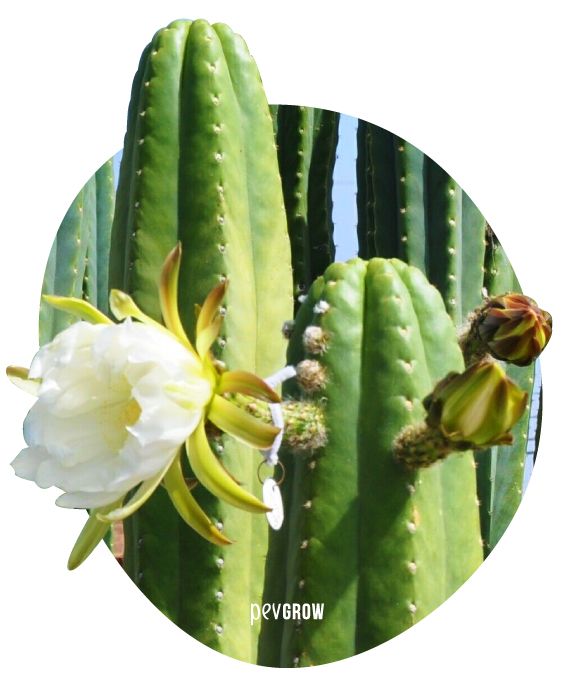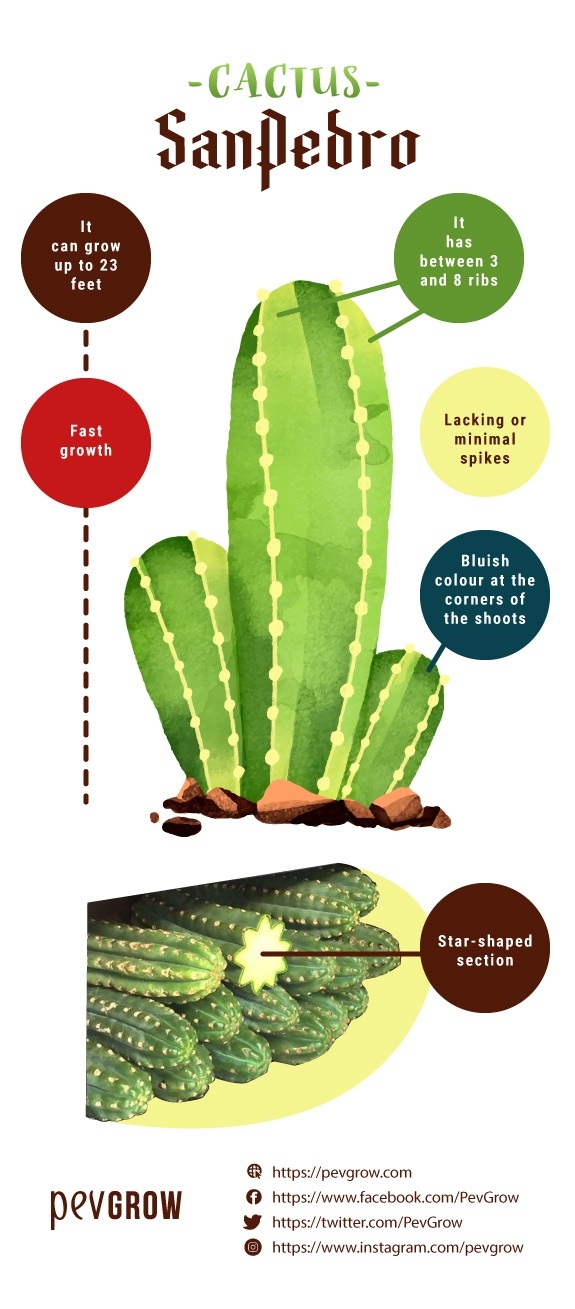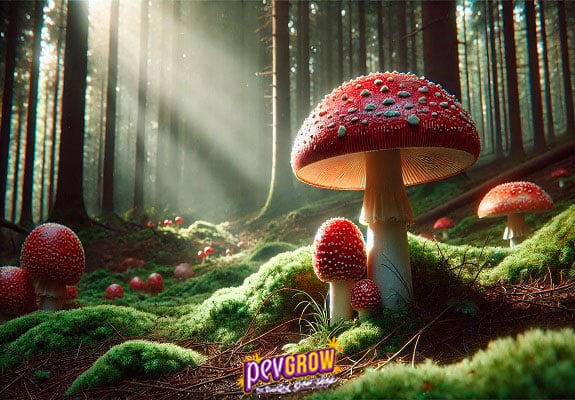

18-09-2020 10:00:04 - Updated: 18 September, 2020
San Pedro is the common name by which we know a species of cactus that contains mescaline. Its real name is Echinopsis Pachanoi, although until a few years ago it was known as Trichocereus Pachanoi, but it is known by other names such as Agua colla, Huachuma or Gigantón. But that is only the most important variety within the cactus they call San Pedro, of which there are a few variations.
Nowadays its use has spread almost all over the world, especially since 1960, but in its place of origin this cactus has been ingested for more than 1000 years, being one of the longest lasting psychoactive substances discovered by mankind. In this article we will talk about the history of this magic vegetable, the way it is prepared, its consumption, the effects it produces and many other things, so take a seat because this is a rough trip…
⚠️ Where does Echinopsis or Trichocereus Pachanoi come from?
It comes from Peru and Ecuador, especially in the Andes, but thanks to its strength and great adaptability it is now found in many parts of the planet. The oldest archaeological piece with references to San Pedro was found in the temple of Chavin, in the north of Peru, and the experts assure that it dates from 1300 B.C. so it would also be one of the first representations of psychoactive substances by mankind.
At first it seems that they used it as an entheogen to communicate with their God in rituals and religious celebrations. When the European settlers reached the area they ended up with many of the psychoactive substances used by the natives, but luckily the San Pedro was preserved and is still used nowadays.
🧐 What is San Pedro?
Within the plant kingdom it belongs to the family of cactus, from the Caryophyllales order, where many other related types are found. It grows in a columnar shape and has great ability to branch out, forming fleshy green stems.
It can grow up to 20 or 23 feet (6 or 7 meters) high and the flowers come out right at the top of the stems, with white, delicate and fragrant petals. Its fruits are dark green and quite striking.

👾 How to identify San Pedro cactus?
At first sight it is not easy to differentiate this psychoactive cactus from other ornamental ones, you have to pay attention to some details that make the difference:
- It has between 3 and 8 ribs
- Lacking or minimal spikes
- Bluish colour at the corners of the shoots
- Fast growth
- Star-shaped section

✨ Growing San Pedro cactus
Its cultivation is really easy, as it does not require great skill or have special needs. The seeds germinate very well in a mixture of sandy soil with pearlite and some peat. You have to bury them a little, water them carefully, add another layer of soil and if possible cover it with a transparent plastic to increase the humidity and accelerate the germination process. It used to be thought that these cacti were for harsh desert climates, but now it is known that not only do they allow enough watering, but that this increases their rate of development, as long as we do not overdo it, since fungi can appear.
However, although reproduction through seed is easy and its growing fast, most people grow San Pedro through cuttings. It’s as easy as cutting off one end of a grown San Pedro and transplanting it into another pot with a mixture of substrate like the one I told you about earlier. It is recommended to use rooting hormones to improve the process, and during the first few days it’s better if it doesn’t get direct sun.
The best season for sowing, grafting or transplanting is spring. It can withstand a certain level of cold, but below 41º F. (5º C.) its growth is slowed down. It needs direct sun to develop well, watering without soaking the substrate and fertilizing once a month except during the cold months. As for the pests that can affect San Pedro cactus, the cottony cochineal should be highlighted, but by treating it with regular preventive measures you can forget about insect attacks.
🎯 Preparation of San Pedro cactus
1-First of all we have to wait until the San Pedro is at least 1.6 feet (50 cm.) long and 2.75 inches (7 cm.) in diameter to make sure that it contains enough mescaline concentration for one trip.
2-First, the most superficial layer of this cactus must be removed, a transparent skin similar to plastic. Once removed you will see that the outer green part remains, this bark is the one with the highest mescaline content and it can be peeled like a cucumber. This green tissue has to be dried and then measured at an average dose of 0.5 to 1.7 oz. (14 – 50 grams) per person.
3-These pieces of dry green bark have to be placed in a casserole and added to triple the volume of water they take up. Light the fire, cover the pan and bring to a boil. When it has been boiling for about 3 hours, uncover it and add 7 oz. (200 grams) of cane sugar and the juice of a drained lemon and cover it again. Leave it to boil for another 3 or 4 hours, and when the water has been almost completely consumed, leaving 0.8 or 1.2 inches (2 or 3 cm.) at most, it is time to turn off the fire and strain it with the help of a cloth filter or similar. It is necessary to filter several times to try to separate the gelatinous substance it contains from the liquid.
4-Once filtered you can drink the liquid, but there are many people who do not tolerate its taste and prefer to reduce this liquid a little more. To do this you have to keep boiling it until it is reduced to a dark tar-like paste. This paste has to be dried and then it can be ground into a fine powder that can be put into capsules so you don’t taste it.
🚀 San Pedro Effects
The effects usually start to be felt about 30 to 45 minutes after ingestion, in some cases a little longer, and can extend for a long time, between 6 and 18 hours. Mescaline is a phenylethylamine, so it causes different types of effects, including the following ones:
- Euphoria
- Hallucinations
- Kaleidoscopic vision
- Relaxation
- Introspection
- Synesthesia
- Hypersensitivity
- Sense of unity with everything
- Excitement
It is very common to have transcendental experiences, sometimes these substances push you to solve those uncomfortable questions that in a regular condition you prefer not to deal with. That is why it is important the set & setting and be at peace with oneself before using entheogens, otherwise the subconscious can play tricks on us.
✅ Possible side effects of the intake of San Pedro
- Nausea and vomiting
- Panic
- Cramps
- Dizziness
- Palpitation
- Sweats
- Stomach pain
- General discomfort
🔥 Conclusion
Today we have learned to identify San Pedro cactus, where it comes from, how it is cultivated, the way it is prepared and the effects of its consumption. This is a spectacular sacred plant and it must be treated with great respect, but if you do it well, it can become one of the best experiences in your life. If you liked this article about San Pedro cactus consider sharing it on social networks, spreading knowledge is the best way to preserve it, thank you.





Thank you for the great content. I love the little video on preparation!